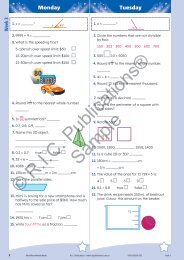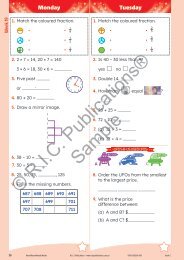PR-0552UK Primary Science - Book 2
You also want an ePaper? Increase the reach of your titles
YUMPU automatically turns print PDFs into web optimized ePapers that Google loves.
Push or pull?<br />
Forces ~ Activity 1<br />
Objectives<br />
• explore how objects may be<br />
moved by pushing and pulling<br />
• become aware of and explore<br />
how moving water and moving<br />
air can make things move<br />
Working scientifically<br />
• Questioning<br />
• Observing<br />
• Predicting<br />
• Investigating and experimenting<br />
• Recording and communicating<br />
Designing and making<br />
• Exploring<br />
• Planning<br />
• Making<br />
• Evaluating<br />
Background information<br />
Pushing or pulling can make objects<br />
start or stop moving, slow down or<br />
change direction. This is known as a<br />
force. The stronger the push or pull<br />
the greater its effect on changing the<br />
movement of an object.<br />
The shape of the part of a toy in<br />
contact with the ground determines<br />
how it can move. For example,<br />
wheels and toys with spherical or<br />
cylindrical shapes can roll; toys with<br />
curves will rock etc.<br />
Before the lesson<br />
Materials needed<br />
• Collect a variety of objects that require a push, pull or both to move or work;<br />
for example, toy cars, pram, wheelbarrow, torch, ring-top can, peg, cradle,<br />
pull-along toy, spinning top, hula hoop.<br />
• LEGO wheels and axles, buttons, bottle tops, lids of various sizes, empty<br />
matchboxes, various sized boxes, yoghurt containers, small juice containers,<br />
aluminium foil, dowelling, pencils, wool, string, sticky tape, craft glue, cardboard<br />
tubes, elastic bands, staplers, materials and fabrics, different types of paper.<br />
• A windy day or a fan, photographs or pictures of yachts on water.<br />
Preparation<br />
• Divide class into small groups with sufficient variety of materials to use for<br />
their ‘toy’. Pre-cut cardboard circles and holes in the middle of lids for axles<br />
etc. Have scissors, retractable safety knives etc. to cut extras for pupils.<br />
The lesson<br />
Stimulus<br />
• Show pupils a tissue box, a torch and a rolling pin. Ask them how they can<br />
make them move (or work). Allow three volunteers to show the class.<br />
What to do<br />
• Discuss the movements each pupil used. Was it a push or a pull? Challenge pupils<br />
to suggest things in the classroom that need a push or a pull; for example, a<br />
chair, door, computer keyboard.<br />
• Ask how a drawer can be made to move. (Pull to open, push to close.)<br />
• Allow pupils to experiment with the provided collection of objects, as well as<br />
others they find inside and outside the classroom. Discuss how some things<br />
need a push to start, but also need a twist (e.g. key in lock) or spin (spinning<br />
top).<br />
• Complete Question 1 on the worksheet to consolidate knowledge.<br />
• In their groups, ask pupils to study the objects provided.<br />
• Tell the pupils they are going to design a yacht that moves on land by wind,<br />
using these objects. In planning the yacht, they will need to think about how<br />
it will catch the wind to move.<br />
• Encourage all pupils to add ideas to the design. One or two pupils can sketch<br />
the design on scrap paper.<br />
• Pupils construct their yacht as a group. Each group demonstrates its yacht<br />
moving to the class. Note: A windy day or fan is necessary here.<br />
• Pupils evaluate their yacht in Questions 4 and 5 on the worksheet.<br />
Viewing Sample<br />
After the lesson<br />
Answers<br />
• Teacher check.<br />
Additional activities<br />
• Bring toys from home to study how each moves. These could include motorised<br />
(battery-operated) toys, wind-up toys and those that do not contain motors.<br />
Display ideas<br />
• Display each group’s yacht with an explanation written by the pupils attached<br />
to it.<br />
72 <strong>PR</strong>IMARY SCIENCE ~ Prim-Ed Publishing ~ www.prim-ed.com


















